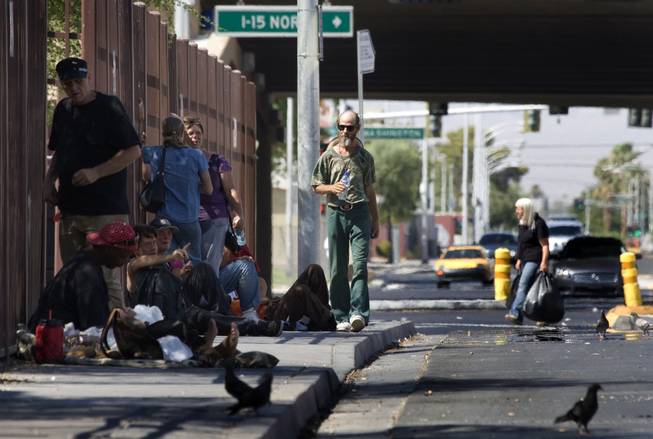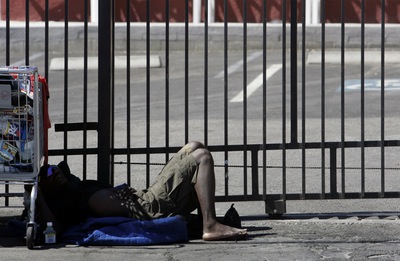
People line up by the fence of the Las Vegas Rescue Mission at Bonanza Road and D Street on Aug. 16.
Wednesday, Aug. 18, 2010 | 2 a.m.
Outdated formulas
Last year, the U.S. Housing and Urban Development Department distributed $1.677 billion nationally to fund programs through the McKinney-Vento Homeless Assistance Act. Two formulas are applied to determine community need. Factors that determine aid per homeless person include age of housing stock and population growth lag, neither of which relates to root causes of homelessness, according to the United Way of Greater Los Angeles.
Another option
HUD is to decide whether to revise the formulas by next year. Communities and agencies in Las Vegas and across the country are mobilizing to urge the federal agency to act. The United Way of Greater Los Angeles, citing a review of existing research and data, says the three key variables highly correlated to increased rates of homelessness are poverty, lack of affordable housing and overcrowding. The United Way is urging that HUD adopt one formula to distribute funding to all U.S. metropolitan areas. It recommends the new formula take into account, for example, the number of each area’s people who live below the federal poverty line, the lack of affordable housing for people living in poverty and the number of overcrowded housing units.
Sun archives
- Couple looks to future after leaving desert homeless camp (7-25-2010)
- As economy sinks, demand for social services soars (7-25-2010)
- Battered women of recession (7-19-2010)
- Las Vegas jobless rate soars to 14.5 percent (7-19-2010)
- The faces of the recession in Las Vegas (12-28-2009)
- Count finds 17 percent increase in homeless population (4-9-2009)
- LV City Council addresses homeless issues (3-18-2009)
- Volunteers seek out valley's homeless for census (1-29-2009)
- Volunteers turn out to help homeless (12-21-2008)
Homeless numbers in greater Las Vegas have topped 13,000, with the recession leaving people jobless, then pushing parents and children out of their homes and onto the street.
It’s happening all around the country, but the human toll here could be compounded because federal formulas lead to uneven homeless funding, giving cities such as Pittsburgh more than $10,000 to serve each homeless person while the Las Vegas area receives about $500 per individual.
Southern Nevada has 2 percent of the country’s homeless, but gets just 0.4 percent of $1.7 billion in funding from the Department of Housing and Urban Development. Funding over the years has fluctuated, providing $5.8 million in 2005, $7 million in 2007 and $6.8 million in 2009.
The huge difference between Las Vegas and other areas recently came up before the Southern Nevada Regional Planning Coalition’s Committee on Homelessness.
Michele Fuller-Hallauer, the group’s coordinator of Continuum of Care, the name for federal programs targeting homelessness, asked the committee to urge HUD to change the funding scheme that leaves the Las Vegas area “the least amount of money per homeless person.”
If funding were evenly distributed to the 640,000 homeless throughout the country, Fuller-Hallauer said, it would increase from about $500 to $2,600 each in the Las Vegas region. Getting five times as much money would boost the coalition’s ability to prevent homelessness, in part by providing housing and rental assistance, she said — even though she doubts a big increase would happen quickly.
“But if we had more money, we could fund more homeless services and get folks off the streets,” Fuller-Hallauer said, adding that the coalition’s 10-year plan focuses on prevention and rapid rehousing. “It would give us more money toward assisting with their rent in transition,” she said.
Because services and shelters are located nearby, the homeless loll up and down the streets of downtown Las Vegas — or get arrested and, without question, make business owners and some of their customers uncomfortable.
For years, the city has tried to redevelop parts of downtown, attempting to draw business to an area that has little foot traffic. While pockets of rejuvenation spring up, Richard Worthington, president of the Molasky Group of Companies and also president of the Downtown Las Vegas Alliance, said, “We as a community are going to have to address homelessness as it affects the perception of personal security.”
Homelessness and loitering are two of the biggest issues facing members of the Alliance, a group working to create a “sustainable urban core.”
“It sets the tone for the area that may end up reducing investment,” Worthington added.
This area’s low federal aid to fight homelessness stems from one of two funding formulas developed in the 1980s. To get HUD homeless grants, communities were evaluated by Formula A, which considers population, poverty and overcrowded housing. Formula B considers population, poverty and housing built before 1940s — assuming older housing means more homeless.
Las Vegas was considered under the first formula.
In 2009, Congress approved the HEARTH Act (Homeless Emergency and Rapid Transition to Housing), opening the door to reconsider HUD’s funding formula. Next year, HUD is expected to decide whether to change it.
Kenny Young, North Las Vegas’ acting city manager who chaired the homeless coalition’s latest meeting, said several communities and agencies, including the United Way, are working together to urge HUD to modify the formulas.
“Right now, money is going to communities where there really isn’t that much of a homeless population,” he said.
Almost all the agencies and communities represented on the Committee on Homelessness signed a letter to HUD. Only Metro Police declined to sign. Deputy Chief Gary Schofield, Metro’s representative on the committee, abstained.


Join the Discussion:
Check this out for a full explanation of our conversion to the LiveFyre commenting system and instructions on how to sign up for an account.
Full comments policy